Designing intelligent & quantum devices and materials for next-generation information systems
Bio
Prof. Priyamvada Jadaun is the Chair Professor of Electrical Engineering and Computer Sciences at the Technical University of Berlin, Germany.
She obtained her B. Tech. in Engineering Physics from IIT Bombay, followed by M.A. in Physics and Ph.D. in Electrical and Computer Engineering from The University of Texas at Austin (UT). She was also a Postdoctoral Associate in Applied Physics at Cornell University and a Research Associate in ECE at UT. Additionally, she pursued brief stints in industry at imec and Applied Materials.
Prof. Jadaun works on the computational design of novel materials and devices, including spintronic, topological and 2D materials. The main applications of her research include the design and development of accelerated hardware for artificial intelligence, neuromorphic computing, and beyond-CMOS computing. Her discoveries include the computational design of the first context-aware artificial neuron that fundamentally outperforms state-of-the-art intelligent devices, oxide materials that show exceptionally large spin Hall effect, magnetic bilayers that show significantly improved skyrmion stability and uncovering the fundamental link between electric polarization and topology. Her work has received multiple accolades including Press Highlight at APS March Meeting 2022, UT Research Showcase, Feature Story by Texas Advanced Computing Centre, Indian Academy of Sciences Summer Fellowship and National Fellowship KVPY, amongst others.
Vision
The essential approach of my research is the computational design of cutting-edge nanoelectronic devices (including spintronic, quantum and neuromorphic devices) that exploit designer nanomaterials with novel functionalities.
The current focus of my research is two fold:
1. Building artificial brains in the lab
2. Developing scalable spin-based quantum computing
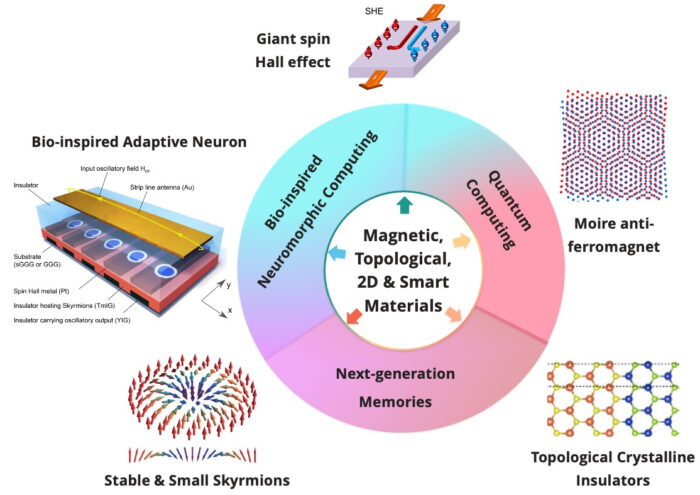
I. Building artificial brains with advanced intelligence & learning
Building machines that possess artificial intelligence (AI) is an intensely pursued research goal. Leveraging cutting-edge materials, including spintronic and quantum materials, I am developing hardware devices that mimic the structural and functional principles of the human brain and possess advanced intelligent and learning abilities. In particular, my vision is to build hardware for ‘Broad AI‘.
The fundamental questions driving my research are:
1. How can innovations in hardware help realize the lofty goal of ‘Broad AI’, i.e. AI with sophisticated cognitive and learning capabilities?
2. How can we develop ultra-low power and ultra-compact devices to unlock the transformative potential of AI?
The first context-aware neuron with high-level intelligence
In recent work, I have designed the first artificial oscillatory neuron that demonstrates adaptive intelligence. Adaptive intelligence is a long-sought ability of the brain whereby the brain can alter its functioning to effectively cope with complex and ever-changing environments, situations, goals and rewards. Powered by intelligent materials, the artificial neuron is also able to modulate its functioning by mimicking a biological process called neuromodulation.
This adaptive neuron is the first context-aware neuron and the first to be able to flexibly compute, both of which are higher-intelligence (cognitive) functions. This neuron has also outperformed state-of-the-art AI at diagnosing breast cancer while using much smaller area and much lesser energy. Such adaptive neurons are an important step towards achieving human-like AI and can have a transformative impact on natural language processing, human-machine collaboration, biomedicine, advanced manufacturing etc.
This work is published in PNAS Nexus and has been selected as ‘Press Highlight’ at the APS March Meeting 2022. It has also been selected for invited talks at APS March 2022 and Intermag 2021.
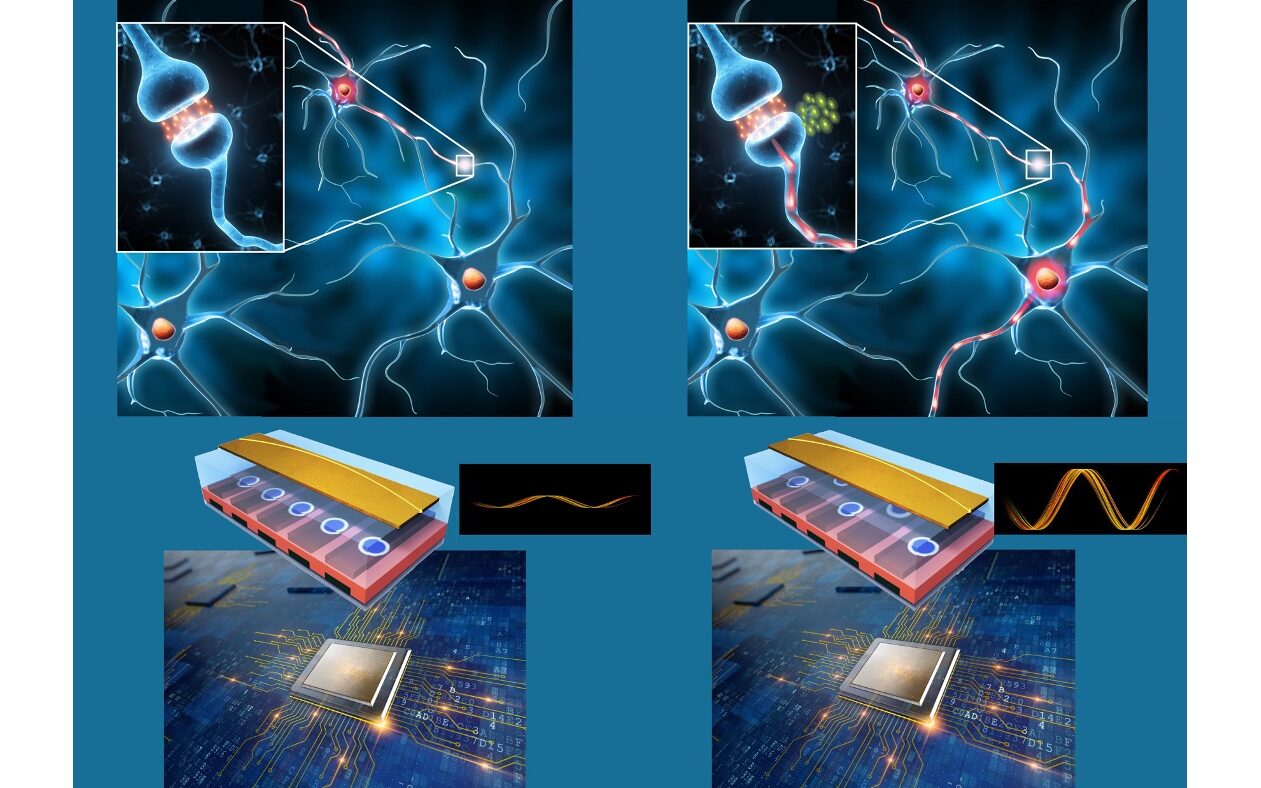
Top half of the image depicts adaptive neurons in the brain, where a neuromodulator (green circles) controls whether a signal (red pulses) from a neuron above is transmitted to a neuron below. The absence (presence) of neuromodulators turns the neuron below OFF (ON) as shown on the left (right). Bottom half depicts the same process in our design. A neuromodulatory signal repositions the skyrmions (blue circles) which alters the neuron’s structure and dynamics. As seen in the brain, the absence (presence) of neuromodulatory signal turns the neuron below OFF (ON), as shown on the left (right).

Designing magnetic skyrmions with exceptional stability
The adaptive neuron described above is built using a lattice of compact magnetic textures called skyrmions. In previous work, I developed novel materials that demonstrate exceptional skyrmion stability.
- Designed new materials with enhanced stability of magnetic textures called skyrmions that is 2-3 times the state-of-the-art.
- Discovered the fundamental origin of skyrmion stability.
- Highly promising for advanced neuromorphic and ultra-low power memory devices.
- Published in Nature Partner Journal Computational Materials.
- Led to experimental realization of skyrmions that are stable in the absence of external magnetic fields.

Designing giant spin Hall effect
The adaptive neuron also utilizes large spin Hall effect, a phenomenon by which a material converts a charge current into a spin current. In previous work, I discovered novel materials that demonstrate exceptionally large spin Hall effect.
- Discovered novel materials with giant spin Hall effect (SHE), 10 times the state-of-the-art.
- Found five fundamental conditions that generate large values of SHE in materials.
- Highly promising for neuromorphic and ultra-low power memory devices.
- Published in PNAS and selected for ‘UT Research Showcase’ and a ‘Feature Story’ by Texas Advanced Computing Centre media.
- Led to experimental realizations of large SHE in oxides with structural distortions published in Advanced Materials and Advanced Functional Materials.

Applications – Wearable Neurotechnology, Biosensing & AI at the Edge
Ultra-low power & broad AI can fundamentally transform a variety of fields including:
- Beyond-CMOS computation
- Neurotechnology, Biomedicine, Biosensing and Human-Computer Interface
- Robotics and Autonomous systems
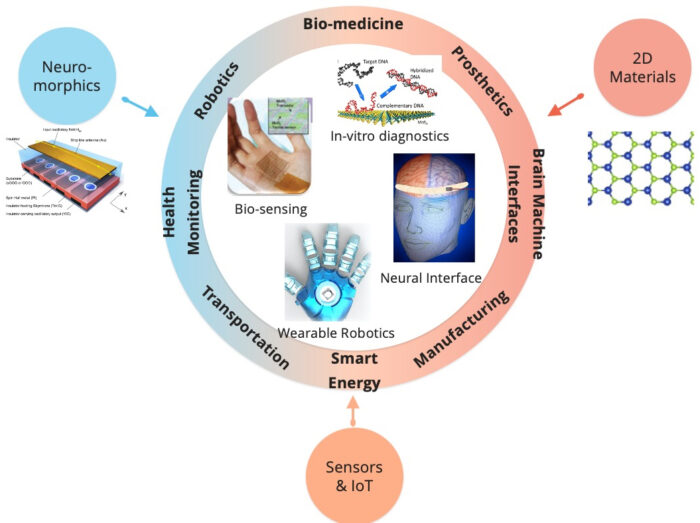
II. Scalable spin-based quantum computing
Designing an antiferromagnet in moiré materials
Recently, I have designed a novel layered orbital antiferromagnet by stacking two moiré layers of twisted graphene. This antiferromagnet is a candidate for realizing axion insulators that are highly attractive for topological quantum computing.
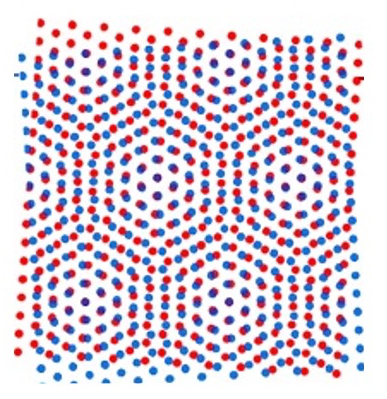
These moiré heterostructures can be used to realize spin qubit-based devices for realizing quantum computing that is reliable, scalable, readable and satisfies the DiVincenzo criteria for quantum supremacy. This work is currently under submission.
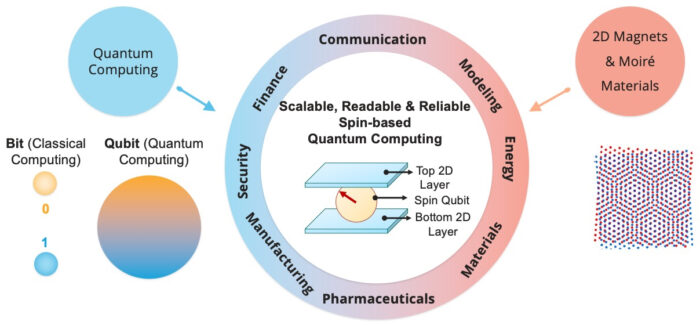
Uncovering the topological origin of electric polarization
In past work, I discovered a new class of topological crystalline insulators that can be easily identified using electric polarization. These materials are highly promising for information superhighways and attractive for carrying information in quantum computing systems.
- Solved the long-standing problem of why electric polarization is quantized.
- Discovered the fundamental link between polarization and topology.
- Discovered new topological crystalline insulators that were experimentally realized and published in npj 2D Materials & Applications.
- Widely cited paper published in Physical Review B.
Large spin Hall effect in lanthanide (Rare-Earth) elements
In past work, I also uncovered the physical origin of the large spin Hall effect seen in lanthanide materials. Large spin Hall effect can be very useful for manipulation of spin qubits in quantum computing systems.
- Developed the 1st code to calculate spin Hall effect from first principles (Github).
- Explained the physical origin of SHE in lanthanides.
- Highly promising for spin-based quantum computing and ultra-low power memory devices.
- Findings published in Physical Review B and selected as Editor’s Suggestion.

Collaborators
- Prof. Dan Ralph, Dept. of Physics, Cornell University
- Prof. Jean Anne Incorvia, Dept. of ECE, UT Austin
- Prof. Sanjay Banerjee, Dept. of ECE, UT Austin
- Prof. Leonard Register, Dept. of ECE, UT Austin
- Prof. John Heron, Dept. of MSE, Univ. of Michigan
- Prof. Qian Niu, Dept. of Physics, UT Austin
- Prof. Di Xiao, Univ. of Washington
- Prof. Gregory Fiete, Dept. of Physics, Northeastern Univ.
- Prof. Hari Nair, Dept. of MSE, Cornell University
- Prof. Seth Bank, Dept. of ECE, UT Austin
- Dr. Vince Lordi, LLNL
Image References: P. Jadaun et al., https://arxiv.org/abs/2010.15748 (under review). I. Kézsmárki et al. Nature Materials, 14, 1116–1122 (2015). J. A. Brock et al., PRM 4, 104409 (2020). 10. C.-Z. Chang and M. Li, J. Phys.: Condens. Matter, 28, 123002 (2016). J. Jang et al., J. Neuroscience 13, 37 (2017). S. Krishnamurthi and G. Brocks, npj 2D Materials and Applications 5, 43 (2021). Wang et al., Adv. Func. Mater. 30, 2003732 (2020). A. Bolotsky et al., ACS Nano 13, 9781−9810 (2019). M. Zhu, Science Adv. 6, 19, eaaz8693 (2020).
